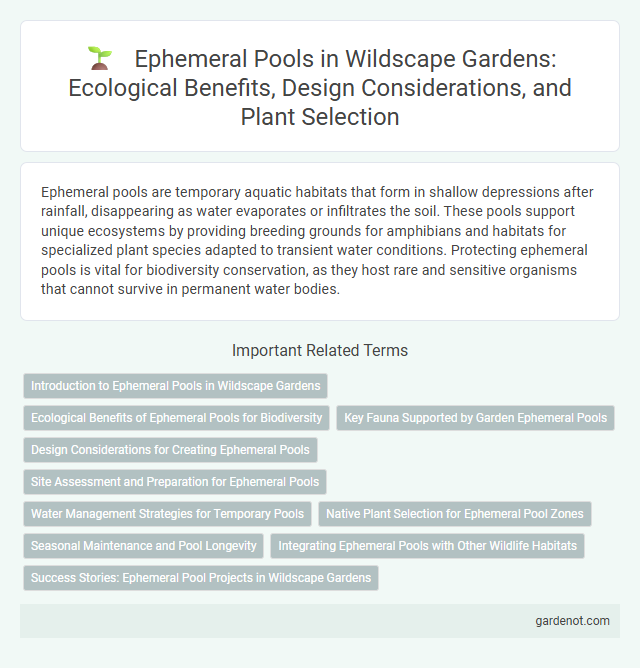Ephemeral pools are temporary aquatic habitats that form in shallow depressions after rainfall, disappearing as water evaporates or infiltrates the soil. These pools support unique ecosystems by providing breeding grounds for amphibians and habitats for specialized plant species adapted to transient water conditions. Protecting ephemeral pools is vital for biodiversity conservation, as they host rare and sensitive organisms that cannot survive in permanent water bodies.
Introduction to Ephemeral Pools in Wildscape Gardens
Ephemeral pools in Wildscape Gardens are temporary water bodies that support diverse aquatic life during their brief existence. These pools form after rainfall, creating vital breeding habitats for amphibians and invertebrates, contributing to the garden's biodiversity. Their dynamic nature supports rare species adapted to fluctuating water conditions, making them key ecological features within the Wildscape environment.
Ecological Benefits of Ephemeral Pools for Biodiversity
Ephemeral pools provide critical breeding habitats for numerous amphibian and invertebrate species, supporting biodiversity in wildscapes by offering temporary, fish-free environments essential for reproduction. These pools facilitate nutrient cycling and serve as microhabitats that sustain specialized flora and fauna, promoting ecological resilience. Their presence enhances landscape heterogeneity, contributing to species richness and ecosystem health within natural habitats.
Key Fauna Supported by Garden Ephemeral Pools
Ephemeral pools in Wildscape provide critical breeding habitats for key fauna such as fairy shrimp, salamanders, and certain amphibian species adapted to temporary water bodies. These pools support diverse invertebrate populations that serve as vital food sources for migratory birds and other wildlife. The presence of ephemeral pools enhances biodiversity by sustaining species with specialized life cycles dependent on seasonal water availability.
Design Considerations for Creating Ephemeral Pools
Design considerations for creating ephemeral pools in Wildscape emphasize soil permeability and natural topography to ensure periodic water retention and natural drying cycles. Incorporating native vegetation enhances ecological function by supporting amphibian breeding and invertebrate diversity while minimizing invasive species colonization. Careful attention to surrounding land use prevents contamination and maintains the pool's role as a dynamic, temporary wetland habitat.
Site Assessment and Preparation for Ephemeral Pools
Site assessment for ephemeral pools involves identifying locations with seasonal water retention, soil composition conducive to temporary inundation, and native vegetation indicators. Preparation includes clearing debris, ensuring natural water flow is unimpeded, and protecting the area from disturbances to maintain habitat suitability. Monitoring hydrology and biodiversity establishes baseline data essential for effective conservation and adaptive management.
Water Management Strategies for Temporary Pools
Ephemeral pools rely on precise water management strategies to maintain their temporary aquatic environments crucial for diverse amphibian and invertebrate species. Techniques such as rainwater harvesting, controlled runoff, and natural infiltration optimize water retention while preventing prolonged flooding or drought conditions. Implementing these methods supports the delicate balance necessary for the pools' seasonal cycles and biodiversity conservation.
Native Plant Selection for Ephemeral Pool Zones
Native plant selection for ephemeral pool zones in Wildscape emphasizes species adapted to seasonal water fluctuations, such as Sphagnum moss, sedges, and rushes. These plants enhance biodiversity by providing critical habitat and food sources for amphibians and invertebrates during the wet phase. Selecting locally sourced native species ensures ecological resilience and supports natural hydrological cycles.
Seasonal Maintenance and Pool Longevity
Ephemeral pools require seasonal maintenance to prevent sediment buildup and invasive species, ensuring optimal water quality throughout their temporary existence. Regular removal of debris and careful monitoring of water levels during wet and dry cycles support the pool's ecological balance and biodiversity. Proper maintenance extends pool longevity by preserving its natural habitat functions and aiding in the survival of specialized amphibians and invertebrates.
Integrating Ephemeral Pools with Other Wildlife Habitats
Integrating ephemeral pools with other wildlife habitats enhances biodiversity by providing critical breeding and foraging grounds for amphibians, insects, and migratory birds. These temporary water bodies connect forest edges, grasslands, and wetlands, creating ecological corridors that support species migration and genetic exchange. Proper landscape design ensures ephemeral pools complement existing habitats, maintaining water quality and promoting resilience against climate fluctuations.
Success Stories: Ephemeral Pool Projects in Wildscape Gardens
Ephemeral pool projects in Wildscape Gardens have demonstrated remarkable success in enhancing local biodiversity and supporting rare amphibian species. These temporary water bodies provide critical breeding habitats for species like spadefoot toads and fairy shrimp, contributing to ecosystem resilience. Monitoring data reveals a significant increase in native flora and fauna diversity, underscoring the ecological value of ephemeral pools in restoration efforts.
Ephemeral pool Infographic

 gardenot.com
gardenot.com